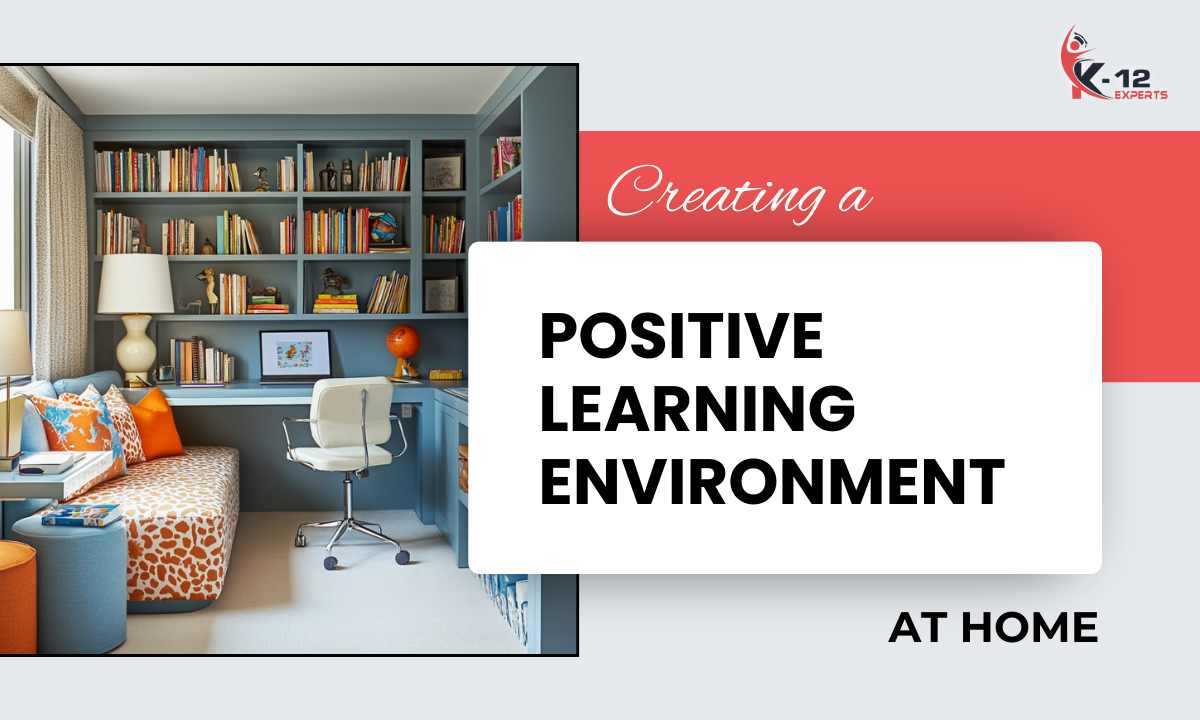As you plan to rearrange your home for a new project, it’s also an excellent opportunity to make it a better place for learning. By organizing your space carefully, you can reduce distractions that often disrupt concentration.
Creating a good learning environment is not just about having a suitable physical space; it’s also about setting up a supportive atmosphere that encourages learning and personal growth. You might wonder how small changes can make a big difference.
Here are some critical steps to transform any room into an effective learning area, which can improve both educational results and general well-being.
First, Choose a quiet corner of your home for study. This area should have minimal noise and disruptions. Equip it with a comfortable chair and a desk with ample space for books and a computer. Good lighting is crucial, so place the desk near a window if possible or add a bright lamp.
Second, consider the decor. A clean, organized space can boost focus. Add some plants for a touch of nature, which can help with relaxation and air quality. Use shelves to keep supplies organized and within reach.
Lastly, Technology is essential for learning. Ensure reliable internet access and consider tools like noise-canceling headphones for online classes. A small whiteboard or bulletin board can help with organizing assignments and deadlines.
With these changes, your home can become a more effective learning environment, making studying more enjoyable and productive for everyone.
Key Takeaways
- Set up a bright, designated area for study to help focus and reduce interruptions.
- Choose comfortable, ergonomic furniture and keep the study space clean to aid concentration.
- Use a variety of educational tools that align with your child’s interests and learning preferences.
- Create a consistent schedule with clear objectives to enhance motivation and develop solid study routines.
- Promote regular breaks in a cozy area and offer helpful feedback, which is crucial for emotional development and learning progress.
Assessing Your Space
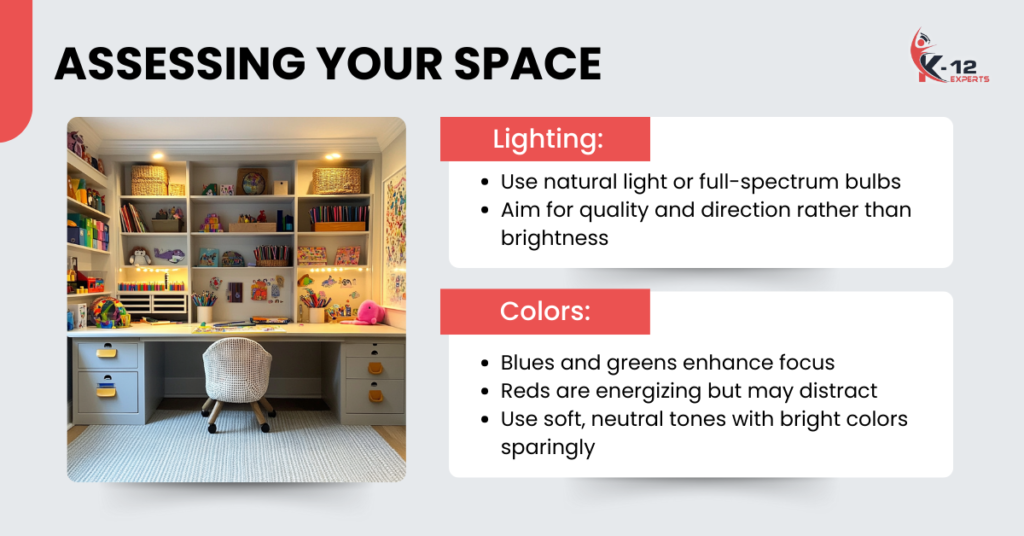
Creating an effective learning environment at home starts with assessing your space. Good lighting and the right colors are crucial.
For lighting, aim for quality and direction rather than just brightness. Natural light is ideal as it helps keep you alert and reduces eye strain. If natural light isn’t available, opt for full-spectrum bulbs, which mimic natural daylight.
The colors in your space also affect your mood and focus. For instance, blues and greens are soothing and can help enhance focus and efficiency, while reds, although energizing, might distract you.
It’s best to paint your walls in soft, neutral tones to maintain calmness, using bright colors sparingly to energize specific areas without being overpowering.
Minimizing Distractions
First, to reduce distractions in your home study area, create a quiet learning space. This helps separate study time from other home activities.
Next, manage interruptions from devices by deciding on specific times when technology isn’t allowed during study hours. This keeps your focus sharp.
Additionally, keep your study area tidy. Clutter can distract you, so having a clean space will aid your concentration. For example, keeping only essential items like textbooks and notebooks can make a big difference.
Using bookshelves or organizers can be helpful for keeping books and supplies neatly stored.
Designate Quiet Study Areas
To improve your learning at home, it’s a good idea to set up a quiet study area. Choose a part of your home that doesn’t get much foot traffic so that you won’t be easily disturbed.
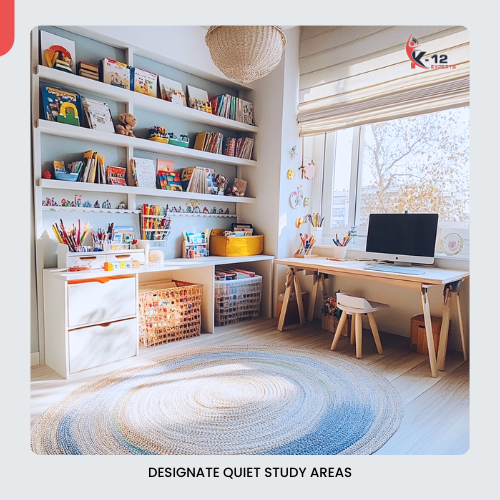
A good study spot keeps you away from daily distractions and helps you focus better. Make sure your study area has good lighting. This is important because proper lighting helps prevent eye strain and can even help you concentrate better.
The main aim is to create a study space that’s both welcoming and practical. This allows you to focus entirely on your studies without being interrupted by other activities in the house.
Limit Digital Interruptions
It’s essential to minimize digital disruptions to improve your learning at home. Creating clear rules for when and how to use digital devices will help keep your attention focused and enhance your ability to learn effectively.
Here’s a simple plan to reduce distractions:
| Action | Benefit |
| Turn off notifications | Helps you avoid frequent interruptions |
| Use “Focus Mode” on apps | Keeps distracting apps out of reach |
| Set specific times for screen use | Organize your day for productive learning |
| Store devices out of view | Lowers the urge to check them constantly |
Organize Physical Space
A well-organized physical space significantly enhances learning. By placing study materials and necessary supplies where you can easily access them, you avoid distractions and can focus better.
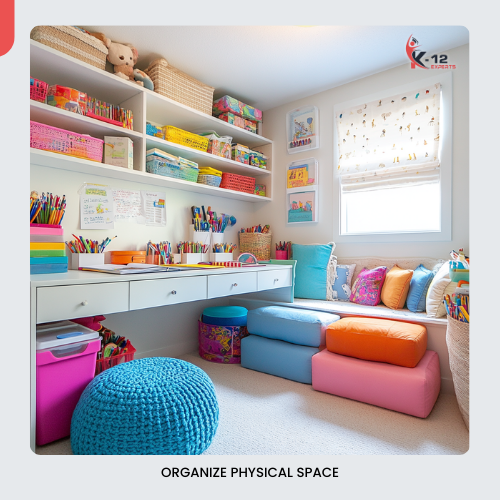
Use furniture that can be adjusted for different activities like reading or writing. Colors also matter; for example, blues and greens can help you concentrate and feel less stressed.
Try to use natural light as it reduces electricity and makes your study space welcoming. Adding personal touches, such as motivational quotes or a small plant, can also inspire and calm you.
The aim is to create a space that allows for freedom and encourages learning.
Integrating Technology
Using technology at home is essential for effective learning. Educational apps and online tools make learning more interactive, creative, and engaging. Virtual classrooms, gamified learning, and digital collaboration foster connection, motivation, and community, even from a distance.
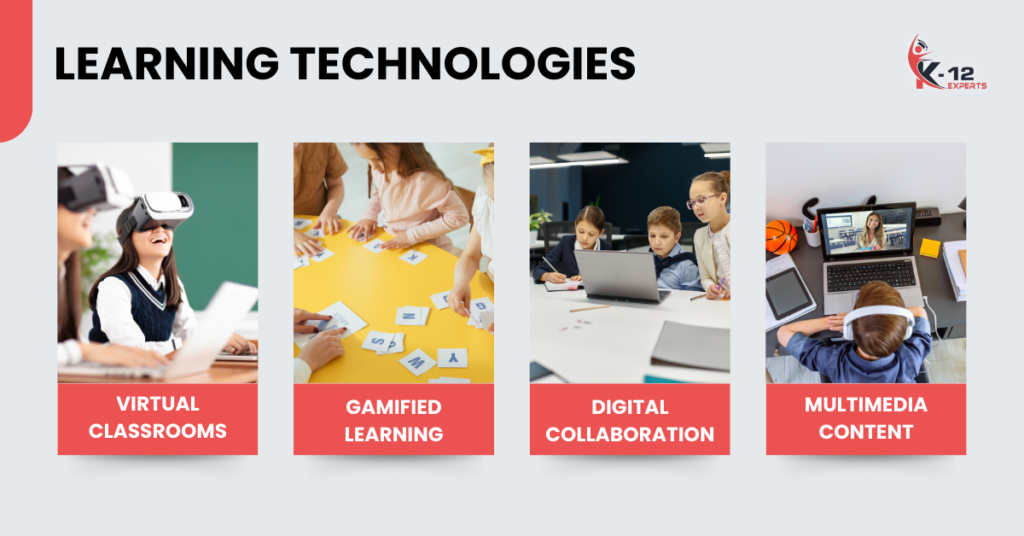
Here’s how these technologies can make you feel:
| Technology | Emotional Impact |
| Virtual Classrooms | Experience the joy and stay motivated |
| Gamified Learning | Experience joy and stay motivated |
| Digital Collaboration | Build a sense of community |
| Multimedia Content | Get inspired and stay curious |
Using technology in learning not only helps with your school work but also makes learning more enjoyable by giving you choices and chances to tailor your education to your interests.
Examples like Khan Academy for math and Zoom for virtual classrooms help make learning more accessible and more enjoyable, keeping you connected and motivated.
Encouraging Organization

Setting up a neat and orderly study space at home is crucial for good learning. To start, choose a specific area just for study. This helps you mentally shift into work mode.
Try to study at times when you feel most alert and productive, as this can help you learn more effectively. It’s also essential to set clear, achievable goals. For example, you might aim to master a particular topic by the end of the week. This keeps you on track and motivated.
An organized study area is more than just tidy—it’s a supportive framework for your studies. It allows you to focus and achieve better results without feeling restricted.
Promoting Comfort and Safety
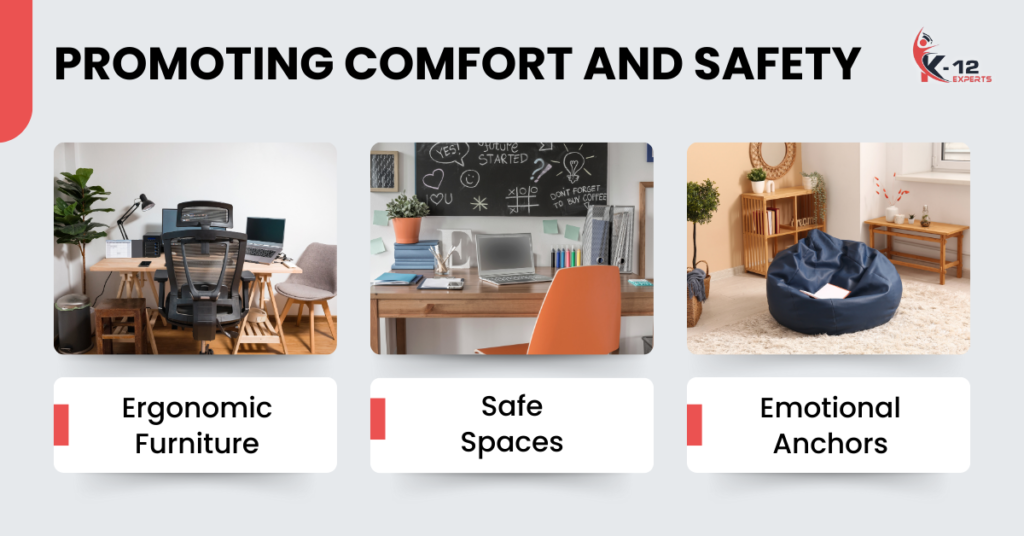
Creating a conducive learning environment at home involves prioritizing comfort and safety. To enhance concentration and overall well-being, it’s crucial to address both the emotional and physical aspects of your space.
Here’s how you can set this up:
- Ergonomic Furniture: Consider using adjustable desks and chairs to promote good posture and physical health, which can be adjusted to fit various body types and provide comfort during long study sessions.
- Safe Spaces: Ensure that all areas used for learning are free of potential dangers and are well-lit. This helps prevent accidents and reduce eye strain. For example, ensure no loose wires are on the floor and use lamps like the e-Reading LED Desk Lamp for proper illumination.
- Emotional Anchors: Set up specific areas for relaxation equipped with items that help soothe and calm the mind. This might include a small nook with a comfortable bean bag, some stress-relief gadgets, or a collection of favorite books.
Such spaces allow for mental breaks and can help refresh focus.
Adapting to Learning Styles
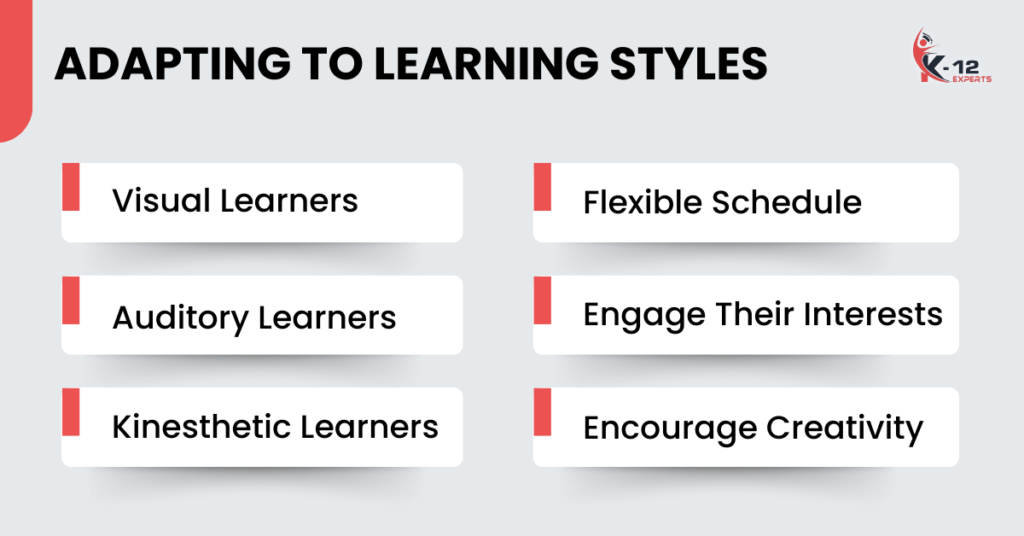
Understanding how your child learns best is crucial for setting up an effective learning environment at home. If your child learns best visually, try using charts, diagrams, and educational videos to help them understand new concepts. This method aids children who absorb information better when they see it visually.
For children who learn through listening, consider incorporating discussions, audiobooks, and songs into their study routine. This approach can make learning more relatable and enjoyable for them.
Children who are kinesthetic learners or learn by doing will benefit from engaging in hands-on activities like science experiments or interactive games that involve physical movement. These activities help them grasp concepts by physically engaging with the material.
To accommodate your child’s natural learning rhythms, consider a flexible schedule. This approach allows them to learn when they’re most alert and receptive, which promotes independence and improves retention.
Make sure to use learning tools and resources that interest your child to keep them engaged. Always provide constructive feedback in a way that encourages and motivates them to do better.
Encourage your child to express themselves creatively and participate in group activities. These practices help enhance their social skills and ability to adapt to different situations.
Conclusion
When setting up your home as a learning environment, it’s about more than just moving furniture around.
You’re creating a space that encourages curiosity and learning. Integrating technology, ensuring comfort, and using effective learning methods can make this space a fertile area for gaining knowledge.
It’s essential to consider every aspect, such as the type of lighting and the way the furniture is arranged, as these elements contribute to a better learning experience.
Take care of this space, and you will see an increase in motivation and achievement.
For example, using adjustable lighting can help reduce eye strain, and choosing a comfortable chair can keep you focused longer.
These thoughtful choices help create an optimal learning environment at home.
Frequently Asked Questions
How Often Should I Update the Learning Space?
Update regularly, ideally with each new season, to keep the space fresh and inspiring. Simple, flexible changes can enhance productivity.
What Are the Best Lighting Options for Studying?
Use natural light paired with an adjustable lamp. Soft, dimmable lighting helps reduce eye strain and improve focus.
How Can Pets Influence the Learning Environment?
Pets reduce stress, boost focus, and help structure your routine, leading to a more relaxed and productive environment.
Are There Ideal Colors for a Learning Space?
Certainly, colors like blue and green promote focus and relaxation. Add these through wall colors or plants to boost productivity.
How Does Outdoor Access Impact Learning at Home?
Outdoor time refreshes the mind and aids focus. Activities like walks or nature-based learning can improve memory and engagement.

